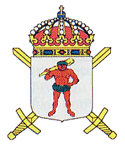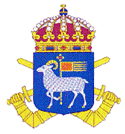

Copyright © Hans Högman 2019-05-20
Swedish Regiments of
the Allotment System -
Infantry (4)
Infantry Regiments:
1. Swedish Regiments -
Infantry (4)

Swedish name: Västerbottens
regemente, I19
The regiment was first established in
1623 as the Västerbotten Regiment.
The regiment was linked to the
Allotment System in February 29 1696.
In 1829 the regiment received the name The
Västerbotten Rifle Regiment (Västerbottens
fältjägarregemente, I19). In 1841 the regiment was
divided into two regiments; The Västerbotten Rifle
Regiment respectively The Norrbotten Rifle
Regiment.
In 1892 the Västerbotten regiment once again
received the name The Västerbotten Regiment
(Västerbottens regemente, I20).
The regiment's history goes back to the "fänikor" that
was raised in the region of Norrland in the 1550's. In
1565 there was a Västerbotten fänika (Västerbotten
is in the region of Norrland).
King Gustav II Adolf formed a "landsregemente" - a
Grand Regiment, from these Norrland "fänikor" in
1615. This grand regiment was called The Norrland
Grand Regiment (Norrlands storregemente) and
numbered 3000 soldiers. 2000 of those solders came
from the former county of Grand Västernorrland
(Stor Västernorrland) and 1000 from the county of
Österbotten (Österbotten is actually in today's
Finland. However, Finland was a part of Sweden until
1809).
In 1623 the Grand Norrland Regiment was divided
into two independent regiments, The Hälsinge
Regiment and The Västerbotten Regiment.
The Hälsinge Regiment's "rotar" were located in
southern Norrland and the Västerbotten Regiment's
"rotar" in northern Norrland. The "rotar" in the
provinces of Medelpad and Ångermanland (in mid
Norrland) belonged to the Västerbotten Regiment.
The companies (of the Västerbotten Regiment) in the
provinces of Medelpad and Ångermanland were
transferred in 1646 to the new regiment; The
Ångermanland-, Medelpad- and Jämtlands Regiment.
Later this regiment received the name, the Jämtland
Rifle Regiment (Jämtlands fältjägarregemente).
As a result of the Constitution adopted in 1634 the
Army was reorganized. The Västerbotten Regiment
was then referred to as the "16th Regiment".
The regiment was allotted with 1056 rotar.
Hence, the Regiment had 1056 soldiers organized
into 8 companies. The regiment's rotar" were
located within the counties of Västerbotten and
Österbotten.
In 1809 when Sweden lost Finland to Russia the
Västerbotten Regiment lost its 113 "rotar" in
Österbotten (Österbotten is in today's Finland). After
1809 the Västerbotten Regiment therefore only had
943 "rotar".
After 1841, when the regiment was divided, the
regiment formed 4 companies of 460 soldiers. The
rest of the "rotar" (483) was transferred to a new
regiment, The Norrbotten Regiment.
Names of the Companies making up the
Regiment in 1682: The Life Company, The
Lieutenant Colonel's Company, The Major's
Company, Lövangers Company, Kalix Company,
Bygdeå Company, Skellefteå Company and Piteå
Company.
Uniform before the standard uniform: Grey coat
with white cuffs (1679). The regiment received the
standard uniform (the blue and yellow Carolean
uniform) in1694.
Location of the primary Garrison of the
Regiment: From 1909, Umeå. Training camp:
Between 1649 and 1898 Gumboda, Umeå
Kronoparken and from 1898 Vännäs.
The Official Regimental Colors: Red and white
Regimental Motto: De hava aldrig svikit eller för egen
del tappat.
Commemoration Day February 3 (in memory of the
battle at Fraustadt in 1706.)
Companies 1841:
Companies 1841, Västerbotten Regiment:
1.
Life Company
2.
Skellefteå Company
3.
Bygdeå Company
4.
Lövångers Company
Companies 1841, Norrbottens Regiment:
1.
Life Company
2.
Piteå Company
3.
Kalix Company
4.
Räneå Company
Victorious Battle Campaigns (segernamn):
•
Landskrona
1677
•
Düna
1701
•
Kliszow
1702
•
Fraustadt
1706
•
Malatitze
1708
•
Strömstad
1717
Swedish name: Kalmar
regemente, I20
The regiment was first established in
June 17th 1623 as the Kalmar
Regiment. The regiment was linked to
the Allotment System in February 26th 1686.
The regiment was disestablished in 1927. This year
the Kalmar Regiment was merged with the Jönköping
Regiment and formed a new regiment called the
Jönköping-Kalmar regiment. The name was later
changed to The North Småland Regiment (Norra
Smålands regemente, I12).
The regiment's history goes back to the "fänikor" that
was raised in the province of Småland (the counties
of Kalmar and Kronoberg) in the 1560's.
In 1616 King Gustav II Adolf formed a
"landsregemente" - a Grand Regiment, from these
Småland "fänikor".
In 1623 the Grand Regiment was split up into two
independent regiments, The Kronoberg Regiment
and the Kalmar Regiment.
As a result of the Constitution adopted in 1634 the
Army was reorganized. The Kalmar regiment was
then referred to as the "17th Regiment".
The regiment was allotted with 1100 "rotar".
Hence, the Regiment had 1100 soldiers organized
into 8 companies. All of the "rotar" were located
within the eastern parts of Småland (347 in the
county of Kalmar, 401 in the county of Jönköping and
352 in the county of Kronobergs).
Names of the Companies making up the
Regiment in 1682: The Life Company, The
Lieutenant Colonel's Company, The Major's
Company, Östra Härads Company, Uppvidinge
Company, Västra Härads Company, Aspolands
härads Company and Konga härads Company.
Uniform before the standard uniform: Grey coat
with green cuffs (1676). The regiment received the
standard uniform (the blue and yellow Carolean
uniform) in 1692.
Location of the primary Garrison of the
Regiment: From 1918, Eksjö. Training camp: 1685
Staby ängar, Oskarshamn, 1783 Mariannelund,
Hultsfred) and from 1797 Hultsfred.
Location of the primary Garrison of the Regiment
for The North Småland Regiment: Eksjö.
The Official Regimental Colors: Red and yellow
Companies 1854:
1.
Life Company
2.
Vedbo Company
3.
Aspelands Company
4.
Östra Härads Company
5.
Seveds Company
6.
Uppvidinge Company
7.
Västra Härads Company
8.
Konga Company
Victorious Battle Campaigns (segernamn):
•
Tåget över Bält 1658
•
Landskrona
1677
•
Clissow
1702
•
Helsingborg
1710
•
Svensksund
1790
Swedish name: Gotlands
regemente, I18
During the Swedish - Russian war of
1808 - 1809, the Swedish Island of
Gotland was invaded by Russian troops
in 1808.
After the war, in 1811, a defense district unit was
established at Gotland called the Gotland National
Conscripts (Gotlands nationalbeväring). It was based
on active service of the population of Gotland. Every
male between the age of 15 (later 18) and 50 were
obliged to do service. Between the age of 50 and 60
they were obliged to assist with military fieldwork.
The conscript unit was organized in three artillery
companies of 90 men each, armed with eight 6-
pound and eight 12-pound guns.
Soldiers in the age between 15 and 30 served in the
Rifle Corps. The Rifle Corps was organized in 16
companies of 150 soldiers each.
Soldiers in the age between 30 and 45 served in the
Infantry Corps. The Infantry Corps was organized in
20 companies of 150 soldiers each.
Soldiers in the age between 45 and 50 served in the
Reserve Corps. The Reserve Corps was organized in 7
companies of 150 soldiers each. They were only
armed with pikes.
In total there were 6,781 soldiers in the Conscript
Corps at Gotland.
The responsibilities for the Corps were to defend
Gotland. They were not suppose to be used
anywhere else. The first commander of the Corps
was Vice Admiral Rudolf Cederström.
In 1861 the Corps were formed in 3 battalions, the
North Battalion with 6 companies, The Mid Gotland
Battalion with 7 companies and the South battalion
with 8 companies.
In 1887 the Gotland National Conscripts Corps was
organized into a regiment and received the name the
Gotland Infantry Regiment (Gotlands
infanteriregemente, I27). A part of the Gotland
National Conscripts also formed the Gotland Artillery
Corps (Gotlands artillerikår).
Between 1928 and 1937 the Infantry regiment was
reduced into a corps with the name the Gotland
Infantry Corps (Gotlands infanterikår, I18).
In 1937 the unit once again was organized into a
regiment, the Gotland Infantry Regiment.
In 1963 the infantry regiment was converted into an
armored (tank) regiment and received the name the
Gotland Regiment (Gotlands regemente, P18).
In 1915 the Gotland Infantry Regiment was the first
regiment in Sweden with a machine gun company.
Location of the primary Garrison of the
Regiment: From 1905, Visby. Training camp: Stånga
malm, Blekväten and Vallstena rum.
Related Links
•
The Allotment System
•
Swedish Wars
•
The Navy & the Army Fleet
•
Swedish Military Unit Designations
•
Swedish Military Branch and Unit Insignias
•
Uniforms of the Swedish Army
•
Source References
Top of page
Infantry Regiments, page:
-1- -2- -3- -4- -5- -6- -7-




16. Västerbotten Regiment, I19
17. Kalmar Regiment, I20
Gotland Regiment, I18


























